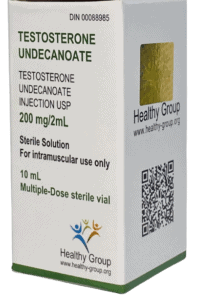Testosterone undecanoate Injection, USP
DIN 00088985
200 mg/2mL
10 mL Multiple-Dose, Cartons of 1 vial

DESCRIPTION Testosterone undecanoate is the oil-soluble undecylate ester of testosterone. Testosterone undecanoate is a white or creamy white crystalline powder, odorless or nearly so and stable in air. It is insoluble in water, freely soluble in alcohol, chloroform, dioxane, ether, and soluble in
vegetable oils. Testosterone undecanoate is a preparation for intramuscular injection. One vial contains 1000 mg of testosterone undecanoate in 10 ml of oily vehicle and is available in a corresponding individual packaging. Testosterone undecanoate injection is an androgen indicated for testosterone replacement therapy for adult males under conditions associated with a deficiency or absence of endogenous testosterone: The FDA approved testosterone undecanoate in March 2014.
COMPOSITION Medicinal ingredients and Non-Medicinal ingredients.
Each 2mL contains; Testosterone undecanoate, 200 mg; benzyl alcohol, 9 mg; Cottonseed oil USP, q.s
CLINICAL PHARMACOLOGY ACTIONSMechanism of actionTestosterone undecanoate is an intramuscularly administered depot preparation of testosterone undecanoate. Following intramuscular injection of testosterone undecanoate as an oily solution, the compound is gradually released from the depot and immediately cleaved by serum esterases into testosterone and undecanoic acid. An increase in serum levels of testosterone above basal values may be seen immediately after administration. The muscle serves as a depot for the sustained release of testosterone into the systemic circulation. Circulating testosterone is chiefly bound in the serum to sex hormone-binding globulin (SHBG) and albumin. The albumin-bound fraction of testosterone easily dissociates from albumin and is presumed to be bioactive. The portion of testosterone bound to SHBG is not considered biologically active. The amount of SHBG in the serum and the total testosterone level will determine the ratio of bioactive and non-bioactive androgen. SHBG binding capacity is high in prepubertal children, declines during puberty and adulthood, and increases again during the later decades of life. Approximately 60 % of testosterone in plasma is bound to SHBG, 2 % remains unbound (free) and the rest is bound to albumin and other proteins.
INDICATIONS Hypogonadism Typical signs of testosterone deficiency, known as hypogonadism, may include: increased irritability or depression, fatigue, decreased concentration, noticeable decrease in lean body mass and increase in fat mass, particularly abdominal fat, decreased libido and sex drive, erectile dysfunction and decreased frequency of morning erections, reduced muscle mass and strength, loss of body hair, and osteoporosis.
CONTRAINDICATIONS The concurrent administration of testosterone with ACTH or corticosteroids may enhance oedema formation; thus, these active substances should be administered cautiously, particularly for patients with cardiac or hepatic disease or for patients predisposed to oedema. Laboratory Test Interactions: Androgens may decrease levels of thyroxin-binding globulin resulting in decreased total T4 serum levels and increased resin uptake of T3 and T4. Free thyroid hormone levels remain unchanged; however, there is no clinical evidence of thyroid dysfunction.
ADVERSE REACTIONS The most frequently reported adverse reactions during treatment with testosterone undecanoate are miscellaneous inflammation, Pulmonary micro embolism of oily solutions can in rare cases lead to signs and symptoms such as cough, dyspnoea, malaise, hyperhidrosis, chest pain, dizziness, paresthesia, or syncope, acne. Prostatic specific antigen (PSA) increased, estradiol increased, hypogonadism, fatigue, irritability, hemoglobin increased, insomnia, and mood swings. These reactions may occur during or immediately after the injection and are reversible. Androgens may accelerate the progression of sub-clinical prostatic cancer and benign prostatic hyperplasia.
WARNINGS Testosterone and derivatives have been reported to increase the activity of anticoagulants. Patients receiving oral anticoagulants require close monitoring, especially at the beginning and end of androgen therapy. Increased monitoring of the prothrombin time, and INR determinations, are recommended.
CARDIOVASCULAR Testosterone can have a strong, negative impact on cholesterol by suppressing HDL cholesterol (good cholesterol) and increasing LDL cholesterol (bad cholesterol). This negative
effect on cholesterol should not be as strong as most oral anabolic steroids, but it will be far more pronounced than most injectable steroids. A cholesterol friendly lifestyle is imperative, which means acholesterol friendly diet rich in omega fatty acids, low in saturated fats, and low in simple sugars. Testosterone may increase blood pressure and should be used with caution patients with hypertension. Edema with or without congestive heart failure may be serious complication for patients with pre-existing cardiac, renal or hepatic disease. Diuretic therapy may be required in addition to discontinuation of the drug. However, it does not appear to negatively affect most healthy adult men in this way.
DOSAGE AND ADMINISTRATION For intramuscular use only. The dosage for Hypogonadism treatment varies according to the age and weight of the individual. In general, these are found as a dosage of 750 mg injected at initiation, at every 4 weeks and every 10 weeks thereafter. Precautions for intramuscular administration of oily solutions should be taken. It should be deeply injected into the muscle group. (see chart of intramuscular injection sites) It is required to follow each injection of testosterone undecanoate by observing patients in the healthcare and medication setting for 30 minutes in order to provide appropriate medical treatment Guide. In the event of serious POME reactions or
anaphylaxis
STORAGE DIRECTIONS Vial should be kept away from light and stored in controlled temperature from 20-25 degree Celsius (68° TO 77°F) Warming and shaking the vial should redissolve any crystals that may have formed during storage. Keep out of reach of children.
